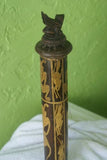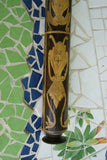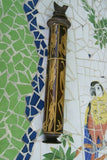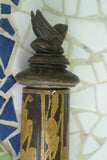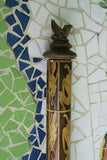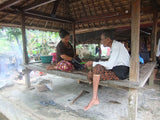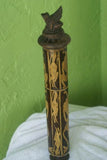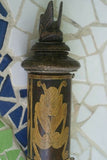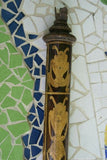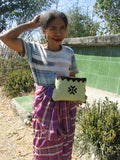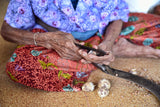Tribal Wood & Bamboo Betel Nut Carrier, Flute container, Hand Carved & Hand Etched Bird Stopper Lid, BNW6, 16" x 3"
Collected on Lombok island, Indonesia, in the late 1900’s.
VINTAGE BETEL-LIME HABIT FLUTE CARRIER.
Great details on this flute carrier from Indonesia.
Incised bamboo body with hand etched detailed motifs of frogs and also devils (to protect from evil lurking in the woods), around the base, topped with a stopper, a nice hand carved wooden lid representing a bird.
ITEM BNW6
Measures: 16" x 3"
Hard to find today.
The habit of betel chewing is believed to have started way back into the Neolithic Age, and for a long time, it was thought to be native to India because of several literary references including a Pali text dating from 504 BC describing this practice. Recent linguistic studies and archaeological finds, however, point to another origin, i.e., southeast Asia.
This conclusion is based on the discovery of traces of the piper betel seeds found in various caves in Thailand and Indonesia dating back to 5,000- 7,000 BC and the discovery of a male skeleton with betel-stained teeth in the Duyong caves in the Philippines dating back to 2680 BC. This habit (betel chewing) spread to cover a large area which included mainland southeast Asia, the Indian subcontinent, Sri Lanka, Indonesia, Papua New Guinea and Micronesia and a custom which was enjoyed by both men and women.
Over the years several accounts of the habit have been written by countless travelers and writers including references to betel and areca in Chinese accounts which date back to the 7th century. They believed that the betel and areca had many medicinal qualities most popular being that of a mouth freshener and it was said that its popularity in China only declined with the introduction of opium in the 19th century. In the “The Travels of Ibn Buttute” in the 13th century he described how he was welcomed by a plate of betel leaves and areca nuts on arrival at the palace of the Sultan of Mogadishu, clearly indicating its association with hospitality.
The foreigners were fascinated and at the same time repelled by the black teeth and the red saliva describing the habit as vile and disgusting, but the habitual users considered these very same things as beautiful. Chewing betel which is a mild narcotic evokes a mild euphoria and a general feeling of well-being. The British anthropologist, Tom Harrison claimed that a few minutes of betel chewing after an hour of hard climbing in Sarawak sent waves of energy through his body.
There are three main ingredients necessary for betel chewing, the betel leaf (from the piper betel vine), lime (from limestone or crushed incinerated sea shells) and the areca nut. One starts with the betel leaf to which the lime is smeared, and a few slivers of areca nut added. The leaf is neatly folded into a small parcel which is called a quid or a “chew” and then popped into the mouth between the gum and the cheek. The Malays add gambir as a fourth ingredient which is said to enhance the flow of saliva, but its primary export value was for tanning leather. Tobacco and spices can also be added depending on taste and custom.
A receptacle was therefore required to house and transport the different ingredients mentioned above, and the Betel Box was born. This can be in the form of boxes, trays, baskets, and bags, fashioned out of silver, gold, brass, bronze, lacquer, wood, ceramic, glass, textile, etc. The shapes and sizes vary to reflect preference gradually becoming a status symbol to indicate the wealth and social standing of its owners.
The grandest usually made of gold were reserved for royalty, and this then became part of the royal regalia in countries such as Burma, Thailand and the Malay sultanates. Over time the popularity of betel chewing waned, and when Malaya became independent from the British in 1957, the betel box was excluded from the royal regalia because it was considered old-fashioned. What has remained is its association with respect and hospitality in Malay custom and tradition and the Betel Box, therefore, plays an important role especially in Malay weddings.
From what was described as an “unlovely practice” by Sir George Scott we have fortunately been left with a very rich inheritance of beautiful Betel Boxes and the various wonderful paraphernalia which were necessary for betel chewing. These include the betel cutters, tobacco boxes, spittoons and mortars which the elderly and toothless needed to pound the ingredients.
We go straight to the source to find these treasures. We have many collector items available, rare pieces from around the world from antique to more recent, designer accents, precious textiles and textile hangers, gifts, rare antique prints, authentic signed paintings and sculptures available on a regular base in our store.




































